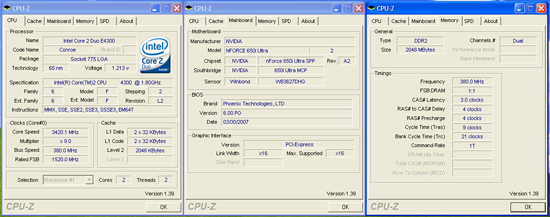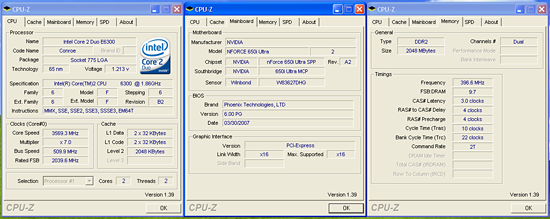EVGA nForce 650i Ultra: Performance on a Budget
by Gary Key on April 10, 2007 2:00 AM EST- Posted in
- Motherboards
Overclocking - E4300
We were able to reach a final benchmark stable setting of 9x380 FSB resulting in a clock speed of 3420MHz. Our E4300 is not the best of the lot and has not gone above 400FSB on several boards so we consider these results to be very good for our particular sample. We were able to POST and enter XP at 9x390 but could not complete our benchmark test suite.
We were able to run our OCZ Flex PC2-9200, OCZ Flex CAS3 PC2-6400, and our Corsair PC2-8888 at the reported timings with a 1T Command Rate enabled with 2.10 V. However, the memory had to be set to Sync mode in order to utilize these timings and command rate. With the memory voltage being limited to 2.1V, it was very difficult finding memory modules that would allow CAS3 and 1T command rate operation while overclocking the FSB. We also had to set the SPP voltage to 1.30V to ensure stability at 1T operation with all of our processors. Vdroop was very acceptable on this board during overclocking with an average drop of .02V during load testing with our E4300.
Overclocking - E6300
Switching to an E6300, we reached a final setting of 7x509 FSB resulting in a clock speed of 3569MHz. We had to loosen our memory timings slightly while overclocking in order to maintain stability at the higher FSB rates. We were not able to run a command rate of 1T past 450FSB and attribute this to crosstalk on the board due to the four-layer design and a lack of memory voltages past 2.1V. We did notice in 4GB testing that we had to change our OCZ Flex PC2-6400 CAS3 memory timings to 4-4-3-10 2T at 2.10V for stable 24/7 operation in a variety of applications. Vdroop was acceptable during load testing with our E6300 with an average drop of .03V.
| EVGA nForce 650i Ultra E4300 Overclocking Testbed |
|
| Processor: | Intel Core 2 Duo E4300 Dual Core, 1.86GHz, 2MB Unified Cache 800FSB, 9x Multiplier |
| CPU Voltage: | 1.4625V (default 1.30V) |
| SPP Voltage: | 1.40V |
| FSB Voltage: | 1.40V |
| Cooling: | Tuniq 120 Air Cooling |
| Power Supply: | OCZ ProXStream 1000W |
| Memory: | OCZ Flex XLC PC2-6400 (2x1GB) |
| Video Cards: | 1 x MSI 8800GTX |
| Hard Drive: | Western Digital 150GB 10,000RPM SATA 16MB Buffer |
| Case: | Cooler Master CM Stacker 830 |
| Maximum OC: | 380x9 (3-4-4-9 1T, 760MHz) 3420MHz (+84% CPU) |
| . | |
 |
| Click to enlarge |
We were able to reach a final benchmark stable setting of 9x380 FSB resulting in a clock speed of 3420MHz. Our E4300 is not the best of the lot and has not gone above 400FSB on several boards so we consider these results to be very good for our particular sample. We were able to POST and enter XP at 9x390 but could not complete our benchmark test suite.
We were able to run our OCZ Flex PC2-9200, OCZ Flex CAS3 PC2-6400, and our Corsair PC2-8888 at the reported timings with a 1T Command Rate enabled with 2.10 V. However, the memory had to be set to Sync mode in order to utilize these timings and command rate. With the memory voltage being limited to 2.1V, it was very difficult finding memory modules that would allow CAS3 and 1T command rate operation while overclocking the FSB. We also had to set the SPP voltage to 1.30V to ensure stability at 1T operation with all of our processors. Vdroop was very acceptable on this board during overclocking with an average drop of .02V during load testing with our E4300.
Overclocking - E6300
| EVGA nForce 650i Ultra E6300 Overclocking Testbed |
|
| Processor: | Intel Core 2 Duo E6300 Dual Core, 1.86GHz, 2MB Unified Cache 1066FSB, 7x Multiplier |
| CPU Voltage: | 1.4500V (default 1.3250V) |
| SPP Voltage: | 1.50V |
| FSB Voltage: | 1.40V |
| Cooling: | Tuniq 120 Air Cooling |
| Power Supply: | OCZ ProXStream 1000W |
| Memory: | OCZ Flex XLC PC2-6400 (2x1GB) |
| Video Cards: | 1 x MSI 8800GTX |
| Hard Drive: | Western Digital 150GB 10,000RPM SATA 16MB Buffer |
| Case: | Cooler Master CM Stacker 830 |
| Maximum OC: | 509x7 (3-4-4-10 2T, 793MHz) 3569MHz (+91% FSB/CPU) |
| . | |
 |
| Click to enlarge |
Switching to an E6300, we reached a final setting of 7x509 FSB resulting in a clock speed of 3569MHz. We had to loosen our memory timings slightly while overclocking in order to maintain stability at the higher FSB rates. We were not able to run a command rate of 1T past 450FSB and attribute this to crosstalk on the board due to the four-layer design and a lack of memory voltages past 2.1V. We did notice in 4GB testing that we had to change our OCZ Flex PC2-6400 CAS3 memory timings to 4-4-3-10 2T at 2.10V for stable 24/7 operation in a variety of applications. Vdroop was acceptable during load testing with our E6300 with an average drop of .03V.










18 Comments
View All Comments
Zak - Tuesday, April 10, 2007 - link
Is there a SPDIF out bracket included? I'd find that a show stopper if it wasn't. Also, regarding the layout: with more and more video cards being quite large these days why they don't allow some extra space between the PCIx graphics slot and the next slot? This is a huge problem with mobos IMHO. Just because I want non-SLI, midrange motherboard doesn't mean I won't have a high end video card in it. Zak.saratoga - Tuesday, April 10, 2007 - link
I noticed the onboard sound benchmarks, but theres nothing about the onboard sound quality. Rightmark has a benchmark for this that take 2 minutes to run and spits out very useful information. Why not include those results like some other sites do?While knowing how it performs is great, knowing if the results are worth listening to is also important. I don't care if its the fastest onboard sound in the world, if its got poor SNR figures, I'm probably going to buy a PCI card :)
yacoub - Tuesday, April 10, 2007 - link
Added two items to your list of desired additions. If a 650i Ultra board came out with the above features, it'd be worth an additional 25% in price to me. (i.e. $125)
It's still practically amazing how well the C2D chips OC even on this board with its somewhat limited overclocking features. =)
Thanks again for a great review Gary.
yacoub - Tuesday, April 10, 2007 - link
Thanks for including the benchmarks with a real-world system. It's neat to see how incredibly different most of the test results are compared to your monster rig with XLC Flex RAM and an 8800GTX. ;)yacoub - Tuesday, April 10, 2007 - link
So don't buy this board if your DDR2 sticks want to run at 2.2v or 2.3v.
yacoub - Tuesday, April 10, 2007 - link
Ah yes, there you go:So time to wait and see if any other folks (Asus, Abit, MSi, etc) come out with a 650i board that offers better adjustment options in the BIOS.
Also would like to see a fully solid-capacitor design as well. Wouldn't mind paying $120-$125 for one of these 650i Ultras with those features added.
yacoub - Tuesday, April 10, 2007 - link
I'm really glad you posted that nice feature chart on page 2 because I didn't know that only 680i boards got the EPP compatibility. Boy it sure would suck to spend extra money on nice high-performance DDR2 RAM that advertises really nice timings when EPP is enabled, only to find out your nice new 650i SLI or Ultra board doesn't support EPP.nullpointerus - Tuesday, April 10, 2007 - link
I'll probably be getting one of these when I upgrade to C2Q late this year. From my browsing experiences, the current crop of Core-compatible boards are much too expensive or lack the new features I would like to gain by upgrading to the new platform. Kudos to EVGA for bringing a solid mid-range board to market!I'm glad to hear nTune (almost) works properly with this board. On my NF4 Ultra board, nTune crashes everytime I try to bring up the system status/overclocking stuff, and BTW the software is a pain to get working in Vista--something like six error messages come up when started without administrator permissions. Hopefully, the Vista issues will be resolved in a few months.